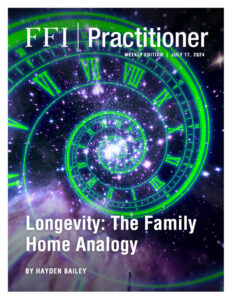
View this edition in our enhanced digital edition format with supporting visual insight and information.
Continuing our quarterly series on the FFI conference theme, “Mean Time: Time, Timing, and Timelessness in Family Enterprise,” through the month of July we are pleased to feature issues related to presentations that will be made in London in October. Thank you to Hayden Bailey for this week’s issue, which is based on his upcoming presentation with Clare Stirzaker about the “The 100-Year-Old Founder CEO.”
We are living longer and, importantly, this means we are extending the active and productive periods of our lives. Mantras in the Hindu Vedas pray to live to see one hundred autumns;1 proponents of dementia-combatting technology speak of having one hundred good years. For family businesses, increased longevity of the incumbent generation can have positives in terms of stability and experience, but also creates challenges to a successfully managed succession. Our FFI conference session “The 100-Year-Old CEO” will explore these issues and establish ground rules aimed to ensure family businesses can make effective decisions and grow through a potentially much longer handover period. In this extract, we explore the analogy between a family business and the “family home” and the impact that longevity can have in practice.
Before the 1990s it would generally be the case that children would leave the family home after completing their education. For example, in the UK, housing stock was generally considered more affordable relative to wages2 and those born post-WWII who were first buying homes in the 1960s and 1970s might be able to purchase a larger family property relative to their parents. With average life expectancy in 1970 around 70 years,3 the older generation would be less likely to be living by the time their children had reached age 60. In the UK those post-WWII children enjoyed a relative period of prosperity and free higher education, so many children of the 1970s and 1980s continued to live at home until their mid- to late 20s.4 According to the European Commission in 2021 the average age to leave home in the EU was 25.5 for women and 27.4 for men.5 According to a 2023 Harris Poll for Bloomberg, roughly 45% of people ages 18-29 are living at home with their families.6 Often associated with living at home is commentary around a lack of independence, feelings of constriction, and being treated like children, as well as occasional accusations of apathy and even laziness, continuing to be “on the payroll” and a financial burden on the older generation homeowner.
Is it possible to draw comparisons between the family home and the challenges of family business succession and older generations seeking to have 100 good years? Yes and no. There are similarities, but every situation is different, and every family business is different. The potential benefit of drawing any comparison is to enable business owners of the older and younger generations to be able to visualize something tangible in terms of “bricks and mortar” and then to use that tangibility as a discussion topic for analysis of similarities or dissimilarities of their family businesses.
At the risk of disappearing into the analogy, let us consider two fictional examples. The parents of Family A and Family B are now both 65 years old. The parents in Family A own a modest house with four bedrooms and a small garden and have paid off their mortgage. They are therefore reasonably successful first-generation entrepreneurs, with a debt-free asset. Our Family B parents, also in their sixties, inherited their family estate and moved into the home in 1985. The house is grand and full of history, with eight bedrooms and a substantial garden and grounds. The house needs repair and is expensive to run, and Family B have some debt against the property. In Family A, their two children moved out of the modest home when they left education and are currently renting elsewhere. Family B has five children and three of them remain living at home. The other two children are renting, and to an extent, they are waiting for their inheritance so they can buy somewhere.
With these two simple examples, it is easy to make observations that apply equally to the concept of family home and family business. For Family A, the children are renting and so likely to anticipate some level of inheritance to help them onto the housing ladder. However, in this scenario, while both children grew up at home, there is no sense of legacy or continuity and the parent’s home will be sold on death or during lifetime if, e.g., nursing home care is required. The house is not big enough for the children and their future families to live in. Because keeping the house is not a viable option, emotional conversations around retaining the house do not feature. If the parents live to 100 then the children may struggle to buy their own property or to make savings, but their expectations have been managed; they are aware from an early age of the need to make their own way and not to place reliance upon their inheritance.
For Family B, whose parents have second-generation wealth, the position is quite different. The house and gardens are full of memories and family stories. The parents are still active in their sixties and the decor and landscaping are how they want them. The children sometimes suggest making changes, but they are often given relatively closed-ended “chores” to complete rather than any real control over capital. There is debt to be serviced, and so much time is spent ensuring that things continue as they are, that there is little time to have wider conversations about whether to extend the property or even to relocate, perhaps where the threat of local development is reduced. The youngest of the three children at home spends a lot of time running errands for the parents and there is a sense that the parents continue to enjoy all of the benefits of the property but are slowly becoming less able to contribute meaningfully to the work required to maintain it. The oldest child at home feels particularly frustrated and would like at least to be the one cooking the Christmas dinner this year. Conversations about selling up and splitting the proceeds are taboo and lack an effective manager, with the easiest option being to retain the status quo and just about get by. The two children who moved out are finding relations with their siblings becoming strained, as they see no real prospect of receiving their inheritance, particularly as all money seems to go into repairs and maintenance. The family’s challenges are that there is no sign of things changing, and the healthy and active parents see the house as their “forever home.”
For a multi-generational family business, the analogy may be unfair, but it is designed as a tool to assist conversation and to highlight the importance of early planning and putting in place a governance framework early. The conference session will touch on this analogy and explain the importance of communication and planning within a family business context. It is essential to agree suitably in advance when the older generation will retire, what that retirement looks like in practice, and how it will be funded. This may require downsizing the businesses or taking on more debt, so that a clean and defined transition can take place. A protocol for making key decisions, such as new business ventures, re-investment and dividend policy, and even a sale must be easy to implement and follow and agreed as being in the best interests of everyone at an early stage.
References
1 Griffith, Ralph T.H. “Hymn LXVII.” The Hymns of the Atharvaveda, 1895-1896. https://sacred-texts.com/hin/av/av19067.htm.
2 Borrett, Amy. “How UK House Prices Have Soared Ahead of Average Wages.” The New Statesman. May 20, 2021. https://www.newstatesman.com/politics/2021/05/how-uk-house-prices-have-soared-ahead-average-wages.
3 World Population Prospects 2022, Online Edition. United Nations, DESA, Population Division. Accessed July 5, 2024. https://population.un.org/wpp/Graphs/DemographicProfiles/Line/826.
4 Thomas, Maddie and Katie Cunningham. “‘It’s Become a Lot More Like a Share House’: When Adult Children Stay in the Parental Home.” Guardian. August 12, 2023. https://www.theguardian.com/lifeandstyle/2023/aug/13/its-become-a-lot-more-like-a-share-house-when-adult-children-stay-in-the-parental-home
5 “Archive:Age of young people leaving their parental household.” Eurostat Statistics Explained. Last revised January 30, 2023. https://ec.europa.eu/eurostat/statistics-explained/index.php?title=Age_of_young_people_leaving_their_parental_household&oldid=590885#Gender_differences.
6 Cachero, Paulina, and Claire Ballentine. “Nearly Half of All Young Adults Live With Mom and Dad — and They Like It.” Bloomberg. September 20, 2023. https://www.bloomberg.com/news/articles/2023-09-20/nearly-half-of-young-adults-are-living-back-home-with-parents.
About the Contributor

Hayden Bailey, Partner and Head of Private Client & Tax at Boodle Hatfield, has an extensive range of private client and tax planning experience and advises entrepreneurs, family business owners and city executives on their UK capital taxation strategy, wills, trusts, life assurance-based products, partnerships, shareholder issues and corporate governance. Hayden also advises non-UK domiciliaries on their UK taxation exposure and asset holding structures and Family Office arrangements. He can be reached at hbailey@boodlehatfield.com.

View this edition in our enhanced digital edition format with supporting visual insight and information.





